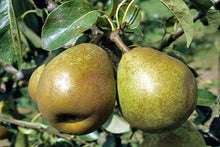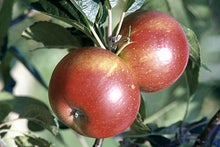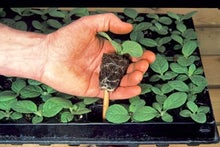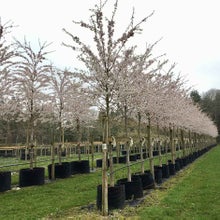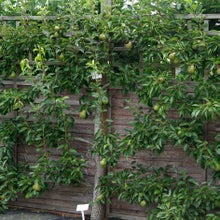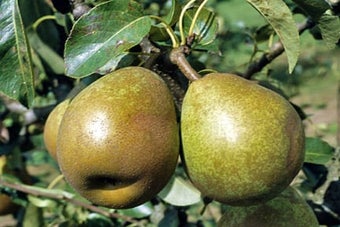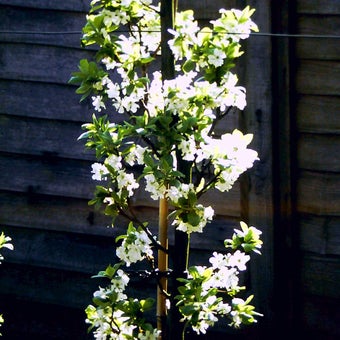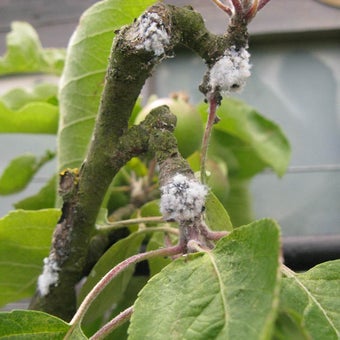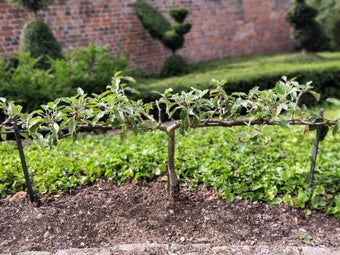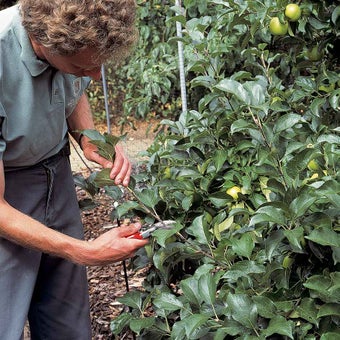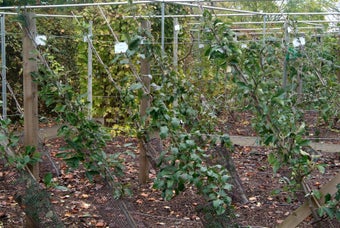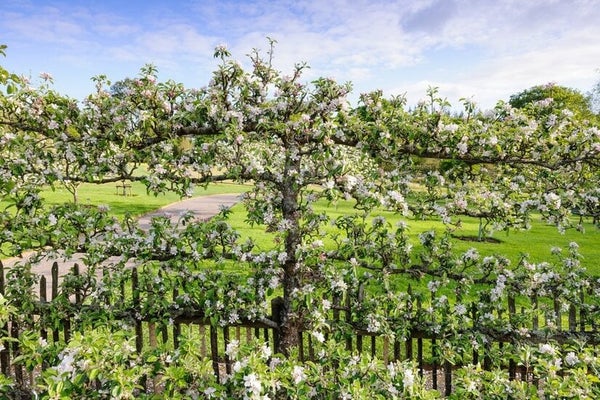
Quick facts
Ornamental, productive and space-saving, ideal for smaller gardens
Needs permanent support, such as a wall or fence, at least 3m (10ft) wide and 1.8m (6ft) tall
Start with an untrained or a partly pre-trained tree
Pre-trained trees need further training to develop more tiers
Select a spur-bearing cultivar grafted onto a suitable rootstock
Unless growing a self-fertile cultivar, a pollinating partner tree is needed
After initial pruning, annual summer pruning is essential to retain the shape
What is an espalier?
An is a tree that is trained flat against a support, such as a wall, with a central vertical stem and several tiers of horizontal branches, generally referred to as arms. It requires careful initial pruning after planting to create the tiers, then annual pruning every summer to keep it in good shape and fruiting well. Espaliers typically have three or four tiers, and reach about 1.8m (6ft) tall and 3–4.5m (10–141/2ft) wide.
When training an espalier, to create further tiers you prune back the main central stem in winter to stimulate the growth of strong side-shoots. These are then trained to form the horizontal arms of the next tier.
Training an espalier is a long-term commitment, so bear this in mind before you begin.
To maintain the shape, it’s essential to prune the horizontal tiers every year in late summer. If left unpruned, growth from the arms will become overly long and more vigorous at the top, eventually reverting to a more natural tree-like form. Espaliers can also be a significant investment, especially if you buy a partially pre-trained tree.
But espaliers offer many benefits too, especially when space is tight, as they:
- have a narrow profile, making them far more compact than free-standing trees
- fruit well for many years
- are an attractive feature, with a well-balanced shape, spring blossom and late-summer fruit
- turn vertical space (which is often under-utilised) into a fruitful opportunity
Before you get started
Only certain types of apple and pear trees are suitable to train as espaliers – find out below which to choose, how much space they’ll need and the different buying options.
Most other tree fruits, such as cherries, plums, apricots, nectarines, quinces and figs, aren’t well suited for training. Fan training fits their growing habit much better. However, some ornamentals, such as pyracantha and wisteria, can be trained this way, making very attractive garden features.
Cultivar choices
Apple and pear trees produce their fruit on different types of shoots depending on whether they’re ‘spur-bearing’ or ‘tip-bearing’ cultivars, and this affects how suitable they are for training as espaliers:
- Spur-bearing cultivars are the best choice for espalier training – these carry their fruit on short side-shoots known as spurs. Check this on the plant’s label or online description before buying
- Partial tip-bearing cultivars may also be used for espaliers, although some are more challenging to maintain than others – see FAQs below
- Tip-bearing cultivars would be very challenging, so are not recommended for espalier training
Ensuring pollination
To make sure you get a good crop on your espalier, the flowers must be pollinated, which usually means you need a ‘pollination partner’ tree (a different of the same fruit) in your own or a neighbouring garden. To be compatible, both cultivars must flower at the same time and be in the same pollination group – the plant label or online description should tell you which pollination group each cultivar is in. Ornamental crab apples are good general pollinators for dessert and cooking apples.
However, if you don’t have room for another tree, and there is no suitable pollination partner nearby, there are a few self-fertile apple and pear cultivars that will produce fruit on their own – see FAQs below.
Espalier sizes and space
Espaliers usually have three or four tiers of branches, which means their support needs to be about 1.8m (6ft) tall, and they typically reach 3–4.5m (10–141/2ft) wide, depending on your choice of tree (see below). Make sure you have sufficient space from the outset – the initial tree may look small, but will soon grow. If you don’t have enough room, choose a more compact training style, such as a cordon.
Apple and pear trees are sold as grafted plants, comprising a cultivar (which forms the upper part) and a rootstock (which controls the plant’s size). The rootstock’s vigour will determine how many tiers you can train and how much wall/fence space it will need. Details of the rootstock will be on the label or online description, so check before buying.
The most suitable rootstocks for espaliers are:
M26 apple rootstock – for smaller espaliers with three or four tiers growing in fertile soil. Final width 3–3.6m (10–12ft)
MM106 apple rootstock – best choice for smaller espaliers with three or four tiers. Final width 3.6–4.5m (12–141/2ft)
MM111apple rootstock – for large espaliers with more than four tiers. Final width 4.5–5.5m (141/2–18ft)
Quince A pear rootstock – best choice for espaliers. Final width 3.6–4.5m (12–141/2ft)
Trees grafted onto more dwarfing rootstocks may be grown as espaliers in containers, which will curb their vigour further. This means they’ll need less space than espaliers growing in the ground.
Untrained or partly trained
You can buy either a partly pre-trained espalier, which will save you several years of training but will be more expensive, or start from scratch with a one-year-old tree. Bear in mind that training an espalier is a long-term process, whichever type you start with.
Partly pre-trained espaliers:
- These usually have one or two tiers already trained by the grower (see photo below)
- They still need further pruning and training to develop more tiers – see Espalier pruning and training
- They are significantly more expensive than untrained trees
- They are available from online suppliers and well-stocked garden centres
- Some nurseries offer trees described as ‘selected for espalier training’ – these are not fully pre-trained trees. They’re likely to be lightly pruned one-year-old trees with well-positioned shoots (known as feathered maidens) that would be suitable for espalier training. Check with the supplier before buying.
Starting an espalier from scratch:
- Buy a one-year-old tree know as a maiden. If it has side-shoots, it’s known as a feathered maiden, if it has no side-shoots it’s an unfeathered maiden
- An untrained tree will be significantly cheaper than a partially pre-trained espalier, but will need several additional years of training
- Choose a spur-bearing cultivar grafted onto a suitable rootstock (see above), depending on how much wall or fence space you have and how many tiers you want to create
- trees are generally only available from specialist fruit nurseries
- For guidance on how to train an espalier from scratch, see Espalier pruning and training
How to support an espalier
Espaliers need a permanent support structure, which should be in place before planting. The traditional method is a series of horizontal wires, spaced 35–45cm (15–18in) apart, attached to a wall or fence or running between posts.
If using posts, make sure they’re firmly anchored in the ground and stand 1.8m (6ft) tall. Space them 2–3.5m (7–12ft) apart. To keep the posts vertical when the wires are tightened, you can also add a bracing support on the inner side, at a 45° angle.
Use robust galvanised wire (2.5mm, gauge 12), kept taut using straining eye bolts. The wire should be held at least 10cm (4in) away from the wall or fence to allow for air circulation.
If starting from scratch with a tree, fix the lowest wire about 40cm from the ground. If planting a partly pre-trained tree, the wires should be positioned at the same level as its horizontal branches. Don’t be tempted to plant more deeply to suit an existing wire – adjust the position of the wire instead. Once planted, the first roots should be just below the soil surface.
If growing the in a large container, you can use a sturdy bamboo or metal frame as support, inserted into the container (see photo below). Alternatively, position the container permanently at the base of a trellis, wall or fence, using the same support method as for a tree growing in the ground.
How to plant an espalier
Apple and pear trees are best planted from late autumn to early spring, while . With a tree, plant it as soon as possible after delivery.
Container-grown trees can be planted at any time of year, but spring or autumn is preferable.
Planting is easy and exactly the same as planting a free-standing tree – see our step-by-step guide to planting a tree.
When planting, make sure the graft union – the visible bump on the lower part of the stem – remains well above the soil surface.
Espaliers can also be planted in large containers – see our guide to growing trees in containers for details.
Pruning and training
Young trees need initial training straight after planting, whether untrained or partly pre-trained, to create the required number of tiers.
They then require annual summer maintenance pruning to keep them in shape and fruiting well.
Frequently asked questions
How can I train a partial tip-bearer as an ?
Although it’s best to use spur-bearing cultivars, it is also possible to train partial tip-bearers as espaliers. Some, such as ‘Discovery’ and ‘Charles Ross’, are easily maintained, but others, such as ‘Worcester Pearmain’ and 'Bramley’s Seedling’, can potentially be difficult to manage.
The key difference when summer pruning is to leave several shorter new shoots that are about 20cm (8in) or less, unpruned every year. These shorter shoots are likely to have developed a fruit at the tip.
I only have space for one espalier – how can I ensure the flowers are pollinated?
If planting just one tree, with no others nearby to act as pollinators, choose a self-fertile or partly self-fertile from the list below. These will fruit on their own, although having a suitable pollinator will usually result in a larger crop.
- Dessert apples:‘Cox’s Selfing’ (a self-fertile of ‘Cox’s Orange Pippin’), ‘Ellison’s Orange’, ‘Greensleeves’, ‘James Grieve’, ‘Red Devil’, ‘Red Falstaff’, ‘Red Windsor’, ‘Sunset’
- Cooking apples:‘Howgate Wonder’, ‘Newton Wonder’, ‘Peasgood’s Nonsuch’, ‘Reverend W. Wilks’
- Dessert pears:‘Concorde’, ‘Conference’, ‘Invincible’, ‘Williams’ Bon Chrétien’


